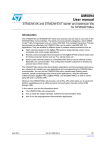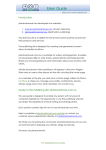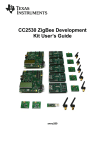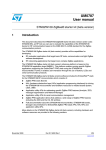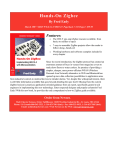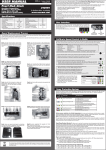Transcript
pump troubleshooting procedures You can troubleshoot most pumping problems in a short time by observing the pressure meter on your pump. The following procedures will show you how. other symptoms If your symptoms differ from these, you may have multiple problems and should use the Modified Ramp Test. This test is also useful if you want to verify your troubleshooting from the above steps or you are unsure of your diagnosis. Ramp Test This is the first test to try, as it involves the least amount of work and disassembly, and it will find most pumping problems. modified ramp test (Perform steps 1 - 5 from the standard Ramp Test.) 1. Disconnect the outlet of the pump from the rest of your HPLC system. 1. Disconnect the outlet of the pump from the rest of your HPLC system. 2. Connect a short piece of tubing to the pump outlet, and put the other end of this tube into a beaker. 2. Connect a short piece of tubing to the pump outlet and put the other end of this tube into a beaker. 3. Prime the pump thoroughly with methanol. Make sure you have drawn enough methanol through the solvent inlet line to ensure the pump is pumping methanol. 3. P rime the pump thoroughly with methanol. Make sure you have drawn enough methanol through the solvent inlet line to ensure the pump is pumping methanol. 4. Remove the tubing at the pump outlet and install a plug fitting to stop flow. 4. Remove the tubing at the pump outlet and install a plug fitting, to stop flow. 5. Set the pressure limit for 4000-5000 psi. 5. Set the pressure limit for 4000-5000 psi. 6. Set the flow rate for 0.3-1.0 ml/min and observe the psi meter and the indicator rods. With a properly-operating pump, you will see a smooth increase in pressure until the pressure limit is reached. 6. D isconnect the tube between the outlet check valve and the reference valve or tee fitting, at the reference valve or tee, on the side of the pump not being tested (if you are testing the left side, disconnect the right side). Below are two examples of the most common symptoms of Ramp Test failure and how to resolve them. The examples use the left and right side to describe the symptoms: interchange the left and right in the text if needed to match your symptoms. 7. P ut a plug fitting into the reference valve or tee where you removed the tube. You may want to put a towel under the open end of the disconnected tube; it will drip a little during the following steps. Do not cap the dripping tube. symptom #1 While watching the left indicator rod coming out, the pressure increases. When the right indicator rod comes out, the pressure stops increasing and stays about the same. When the left indicator rod again begins coming out, the pressure again begins increasing. 8. Set the flow to 1 ml/min, and observe the psi meter and the indicator rod on the side being tested. symptom #1 The pressure increases steadily while the plunger is coming out and holds pressure while the plunger is retracting. Analysis: This pump head is pumping OK. Analysis The right inlet check valve is not working. This symptom is fairly easy to understand. The inlet check valve is either stuck open, and the mobile phase is sloshing back and forth as the plunger goes in and out, or it is stuck shut, never allowing mobile phase into the pump head. symptom #2 The pressure never increases above 0 psi. Analysis: The inlet check valve is not working. Reprime this pump head and try again. If this fails, see Symptom #1 of the Ramp Test to repair. Possible Problem Solution Check valve dirty Clean and rebuild. symptom #3 Seat worn out Clean and rebuild. The pressure increases steadily while the plunger is coming out, but drops abruptly while the plunger is retracting. Analysis: The outlet check valve is leaking back. See symptom #2 of the Ramp Test to repair. symptom #2 While watching the left indicator rod coming out, the pressure increases. When the right indicator rod comes out, the pressure drops almost back to zero. When the left indicator rod again begins coming out, the pressure again increases. symptom #4 The pressure increases steadily during the first plunger out stroke, but increases less during the next out strokes; the pressure holds while the plunger is retracting solution. The plunger seal is beginning to leak, or the inlet check valve is leaking back slightly. To repair, look at the weep hole at the bottom of the support bushing, or between the pump head and the support bushing, and see if the mobile phase has been leaking past the plunger seal. If so, slightly tighten the two allen head screws holding the pump head and retest. If the pump head is tight against the support bushing, it is time to replace the plunger seal. If the inlet check valve is leaking back, see symptom #1 of the Ramp Test to repair. Analysis The left outlet check valve is leaking back. This symptom is more difficult to understand, until you think about where the mobile phase is going. When the left plunger comes out, the pressure increases. When the right plunger comes out, it pumps mobile phase out, into the reference valve or tee fitting, and over to the left side. The left outlet check valve is leaking backwards, allowing what the right side is pumping to enter and fill the left side as the left plunger is going in. other symptoms Possble Problem Solution Check valve dirty Clean in ultrasonic cleaner. Flush thoroughly with methanol in priming syringe. Disassemble and rebuild check valve. Air bubble trapped in check valve Reprime with methanol. If you need any further assistance, please feel free to call 952.895.8292 or toll-free at 800.682.3295 during the hours of 8 a.m. to 5 p.m. CST. Thanks for calling! DAINTREE SCIENTIFIC Tel: (03) 6376 3335 Fax: (03) 6376 3334 E-mail: [email protected] www.daintreescientific.com.au 55
